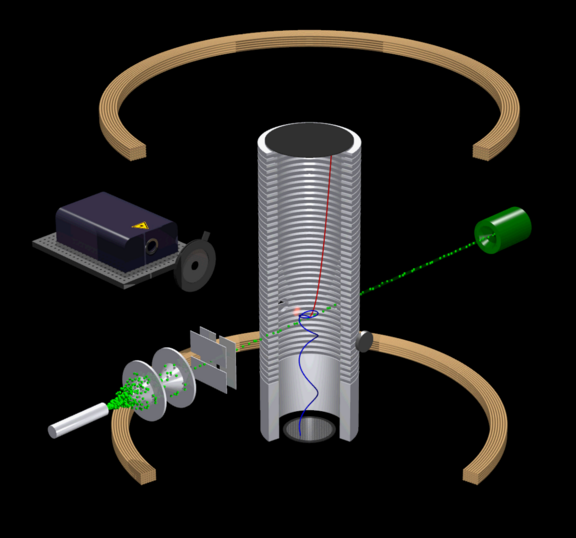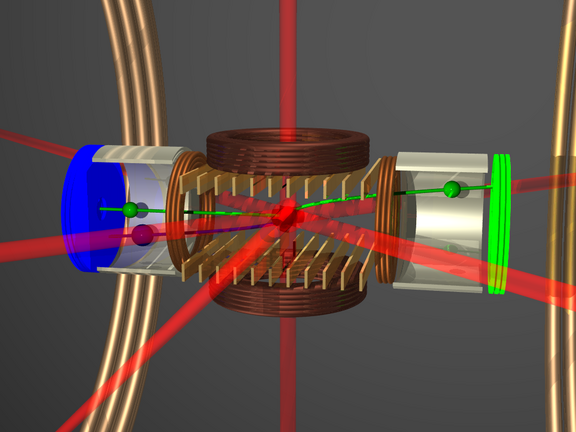Ultrashort Laser Pulses – the Microcosm in Extremly Slow Motion
How does a quantum system evolve in time and is it possible to visualize or even control its motion? Today, this old dream of physicists from the early days of quantum mechanics has become a real and growing field of research. The time scales of processes elapsing in quantum systems are extremely short: During chemical reactions, the atoms are moving within 10 to 100 femtoseconds (1 fs = 10–15 s), while the electrons which mediate the chemical bond are even faster: here, attoseconds (1 as = 10–18 s) are the characteristic time scale.
A key tool for time-resolved experiments are ultrashort intense laser pulses which are used to steer the atomic or molecular dynamics with extremely high precision. An electron released from an atom by a strong laser field is driven back and forth and revisits its parent ion while probing its structure. The wave nature of the electron leads to interference effects like in a holographic image which can be analysed to resolve the time-dependent interaction with the residual electrons of the atom.
In most cases, a “pump-probe” scenario is applied, where the first “pump” laser pulse prepares the system in the desired way and starts the time evolution which is then probed by the second laser pulse. Molecular motions like vibration and rotation can thus be traced. Observing chemical reactions in real time at femtosecond resolution is a very promising research area. In combination with reaction microscopes even the ultrashort time span needed for a rearrangement of atoms within a molecule can be observed.
To observe the motion of electrons, however, even shorter light pulses on the order of attoseconds are required. One possibility therefore is the generation of high harmonics of an intense femtosecond laser. This way, the requested pulse durations of less than 100 attoseconds at wavelengths of some 10 nanometres can be reached nowadays. The helium atom represents a prototype for the correlated motion of electrons. Both its electrons can be excited by absorption of extreme-ultraviolet attosecond pulses. Another femtosecond laser pulse time-dependently probes the thus generated two-electron wave packet which can be reconstructed with the support of calculations that are based on known static wave functions. Laser pulses even allow to steer this electronic “couple dance”. In the future, a directed manipulation of the electron pairs in molecules may influence chemical reactions and enable hitherto impossible syntheses.
Spectroscopy – the measurement of the absorption and emission of light as it interacts with matter – is one of the most important tools of physics. Line spectra appear in the case of resonant interaction. Under certain conditions, they interfere with a continuous background and asymmetric line shapes (“Fano profiles”) emerge. This can be illustrated as the superposition of coupled oscillations. Using ultrashort laser pulses, it is possible to control the temporal evolution and thus the quantum interference – for example to achieve the transformation of a spectral absorption into an emission line and resolve the ultrafast formation of a Fano resonance on the femtosecond timescale.
Reaction Microscopes and Laser Systems
Reaction microscopes – the “bubble chambers of atomic and molecular physics” – have been developed and are continuously improved at MPIK. Ultra-short intense laser pulses or particle beams induce a breakup of simple molecules. The fragment ions and electrons are caught by means of electric and magnetic fields and recorded by large-area time- and position-sensitive detectors. Their complete momentum vectors, and thus the geometry and dynamics of the molecules before their break-up, can be determined from the reconstructed trajectories of the fragments (“kinematically complete experiments”). The instruments are deployed in-house and at external light sources such as free-electron lasers (FELs). For the cryogenic storage ring CSR, a specifically designed reaction microscope is presently under construction. It will be a key instrument for the worldwide unique possibilities for the investigation of slow and cold ions in the CSR.
In the Institute’s laser laboratories, phase-controlled laser pulses as short as 5 femtoseconds at intensities of up to about 1016 W/cm2 are routinely available for experiments. Even shorter pulses of some attoseconds duration are generated by nonlinear optical techniques. The resulting coherent high-harmonic radiation in the extreme UV range can then be combined with broadband infrared/visible pulses from the main Ti:Sapphire laser. Isolated as well as double and triple attosecond pulses are produced and used to probe gaseous atomic and molecular samples by interferometric methods. For pump-probe measurements, the time delay between two pulses can be precisely adjusted on attosecond time scales. Combined with spectroscopy or imaging detectors, this allows for direct and time-resolved observation (and control) of nuclear and electronic quantum motions in chemical reactions.
Colliding Atoms and Molecules – Billiard Game with Quantum Balls
Research on correlated quantum dynamics represents one of the great challenges in contemporary science. Researchers at the MPIK explore quantum dynamics on a fundamental level, starting from a limited number of few interacting particles in atoms and molecules, and extending to more complex finite quantum systems such as clusters or even biomolecules. Bombardment with charged particles (electrons, ions) is a key method for the study of these quantum systems. Novel multi-coincident imaging techniques developed at MPIK provide comprehensive information about few-body quantum dynamics and allow a test of theories for such reactions. Electron impact plays an important role in the environment, for example in the upper atmosphere and in interstellar space, as well as in technical plasmas and in radiation biology. During a collision, a molecule may break up into several fragments; this plays a crucial role in biological tissues, since, e. g., the DNA molecule can be altered chemically or even be destroyed.
Ultracold Dynamics – Investigating Exotic Quantum Gases
Very cold atomic gases with quantum properties are accessible by means of laser cooling. Lithium atoms behave as bosons or as fermions depending on the choice of their mutual interaction. In the bosonic regime weakly bound atom pairs form, the mutual distance of which is experimentally controllable. This exotic form of matter is investigated with a reaction microscope. By ionization of all atoms in bound pairs or in few-particle systems and determination of all ion momenta, it is possible to deduce the initial spatial configuration of the particles. Here practically instantaneous ionization is done by an intense femtosecond-pulsed laser beam. Whether and how the quantum state of the gas influences its ionization dynamics is also of interest.
The Cryogenic Storage Ring
In the electrostatic cryogenic storage ring, CSR, beams of cold molecular ions of any size and highly charged ions can be investigated essentially without any influence of the environment. This is achieved by purely electrostatic ion optics, keeping the ring under extremely low pressure and at a temperature of a few degrees above absolute zero. The ions are produced in dedicated ion sources and injected into the ring by high voltages of up to 300 kV. In addition, a device for injecting beams of neutral atoms is attached to the CSR. An electron cooler improves the stored ion beam quality, and the electrons are available as reaction partners. Sensitive particle detectors in the corners of the ring count even neutral reaction products. For spectroscopic measurements, laser beams can be crossed with the stored ion beam. The innovative mechanical concept of the CSR was developed and realised in close cooperation with MPIK’s engineering design office and precision mechanics shop.
Laboratory Astrophysics – the Chemistry of Space
The chemistry of interstellar space is one of the most active fields of research in astronomy. Modern telescopes have discovered a variety of complex molecules in interstellar nebulae and protoplanetary disks, but the processes – often involving ions – that lead to the formation of large organic molecules under the extreme conditions of cold space still pose a riddle. It is also believed that the origin of life on Earth is closely linked to the formation of biologically relevant molecules in space. The search for interstellar water and prebiotic compounds is therefore the motivation for large international projects.
The gas-phase chemistry is driven by reactions involving ions and radicals which are created in collisions with photons and cold electrons. Here, the H3+ molecular ion plays a key role. The break-up of molecules after capture of an electron (“dissociative recombination”) can be studied in detail in storage rings. In the cryogenic storage ring CSR conditions are reached that correspond to interstellar temperatures where many types of internal motion in molecular ions are in fact frozen.
The positive ions of interest range in size from small atoms and molecules up to organic compounds. Also, negatively charged molecular ions (anions) are of interest here as they represent an important source of slow electrons. Provided sufficient inner excitation (vibration), they can literally “evaporate” electrons. Moreover, collisions with neutral atoms are also of great importance for astrochemistry. A novel neutral-atom beam setup at the CSR has recently been commissioned. It combines ground term atoms with cold molecular ions, and thus, for the first time, provides access to this largely unexplored class of processes under true interstellar conditions.





